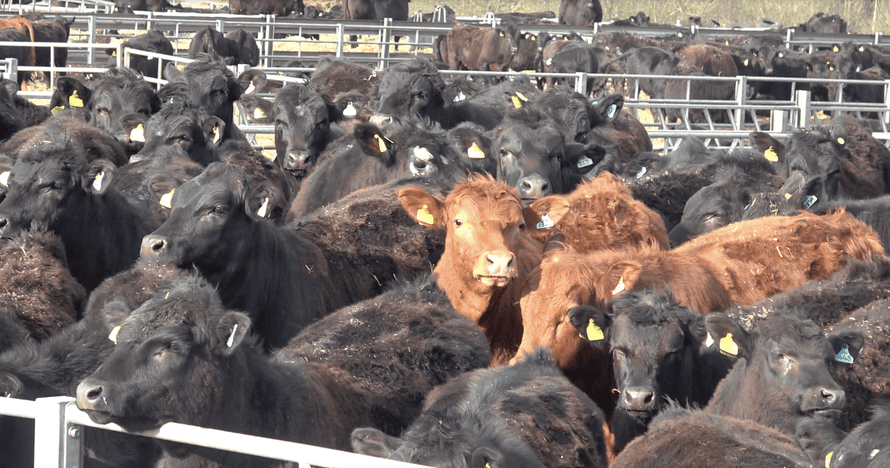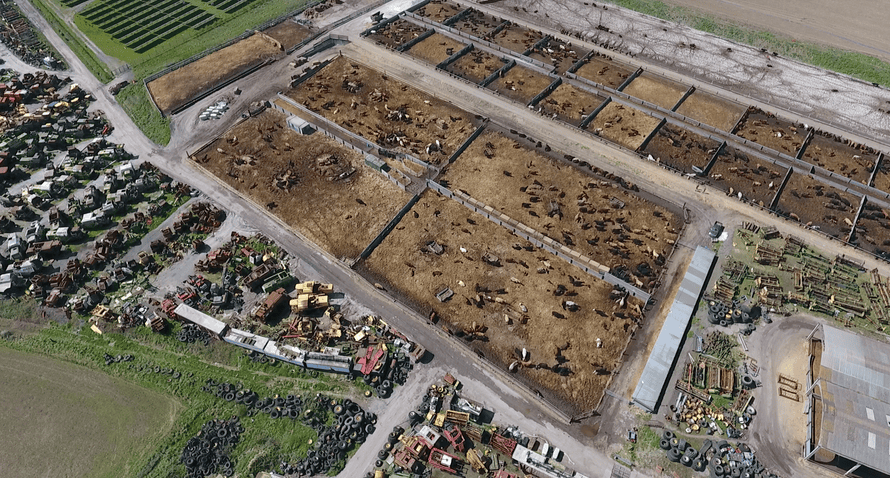Us Beef Production Industrial Vs. Pasture
Thousands of British cattle reared for supermarket beef are existence fattened in industrial-scale units where livestock take piffling or no access to pasture.
Research by the Guardian and the Bureau of Investigative Journalism has established that the U.k. is now home to a number of industrial-scale fattening units with herds of up to 3,000 cattle at a time being held in grassless pens for extended periods rather than being grazed or barn-reared.
Intensive beefiness farms, known as Concentrated Fauna Feeding Operations (CAFOs) are commonplace in the The states. But the practice of intensive beef farming in the U.k. has not previously been widely acknowledged – and the findings have sparked the latest clash over the future of British farming.
The beef industry says that the scale of operations involved enables farmers to rear cattle efficiently and profitably, and ensure high welfare standards. But critics say in that location are welfare and ecology concerns effectually this way of farming, and believe that the farms are evidence of a wider intensification of the United kingdom's livestock sector which is not existence sufficiently debated, and which may have an impact on small farmers.
In contrast to large intensive pig and poultry farms, industrial beef units do not require a government permit, and there are no official records held by DEFRA on how many intensive beefiness units are in operation.
But the Guardian and the Bureau has identified virtually a dozen operating across England, including at sites in Kent, Northamptonshire, Suffolk, Norfolk, Lincolnshire, Nottinghamshire and Derbyshire. The largest farms fatten up to 6,000 cattle a twelvemonth.

Drone footage and satellite images reveal how thousands of cattle are being kept at some sites in outdoor pens, known as corrals, sometimes surrounded by walls, fences or harbinger bales. Although the cattle will have spent time grazing in fields prior to fattening, some will be confined in pens for around a quarter of their lives, until they are slaughtered.
Supermarket demand is believed to be, at least in part, driving the trend. In add-on, some smaller and medium-scale beef producers have struggled to farm profitably in recent years, with sometimes tight margins and fluctuating costs. Most of the units identified are believed to accept grown incrementally, rather than setting up from scratch.
A number of retailers, including the Co-op, Lidl and Waitrose, are among those found to exist sourcing beef from UK intensive industrial calibration farms, near of which are privately owned but sell to beef processing companies, which in plow supply retailers.
Chris Mallon, manager of the National Beef Association (NBA), the industry trade body, said the reason the largest units have come about was purely down to "efficiency".
"What we're talking virtually hither is commercial production, for feeding people. It's not niche market. A lot of this will be on supermarket shelves – that's where it'south coming into its ain. In the catering side also, they'll exist doing it," he said.
"One of the things we've seen over the years is supermarket domination of the beef trade. What they desire is specification, size of cuts, size to fit certain packaging, size of roasts – this has all become incredibly important."
But he cautioned that farms dedicated to fattening cattle had always been bigger than those rearing them, "and so actually having higher concentration of feeding cattle on units [isn't new].
"The difference is we're getting some larger units now and that will be considering of economies of calibration … if you can requite the people you're supplying a constant supply of cattle that are in the correct specification, that makes you lot more valuable. And that'due south one of the reasons we've seen a move towards it."
Dr Jude Capper, a livestock expert who has studied intensive beef units in the Usa and elsewhere said that due to economies of scale "it'southward almost inevitable that a larger farm tin can produce a greater quantity of a more than affordable production – we encounter this in virtually all agricultural sectors globally, only equally we do in other industries".
The Guardian and Agency last yr revealed that 800 poultry and pig "mega farms" or CAFOs have appeared in the British countryside in contempo years, some housing more than a million chickens or about twenty,000 pigs.
Post-obit the revelations, the environment secretarial assistant, Michael Gove, pledged that Brexit would not be allowed to outcome in the spread of United states of america-way agribusiness: "I do not desire to see, and nosotros will non have, US-style farming in this country," he said in a parliamentary statement.
Although the number of beef units is tiny in comparison with intensive poultry or pig farms, the latest findings accept further fuelled fears that the UK could be embracing industrial-scale practices.
Caroline Lucas, MP for Brighton Pavillion, said the farms were "gravely concerning" and that "with Britain hurtling towards Brexit, and with our animate being and environmental protections facing an uncertain future, I'm worried that nosotros could terminate upwards adopting more than of this United states-fashion agricultural practice".
Richard Immature, Policy Manager at the Sustainable Food Trust, said: "Keeping large number of cattle together in intensive weather condition removes all justification for rearing them and for consumers to eat red meat... More than two-thirds of Great britain farmland is under grass for sound environmental reasons and the major justifications for keeping cattle and eating ruby meat are that they produce high quality protein and healthy fats from land that is not suitable for growing crops."
Young added that that smaller calibration beef farmers might feel the impact, as larger farms were probable to be "more efficient in purely economic terms", allowing the supermarkets "to drive down the retail cost of beef beneath the price at which more traditional farmers tin produce it. As a result they go out of business."
The changing face up of traditional United kingdom of great britain and northern ireland beef production
Beef production in the UK typically involves three distinct stages - calf rearing, growing and fattening - with many farms specialising in one part of the rearing process. Cattle may motion betwixt a number of different farms during their lifecycle. (A smaller number of farms rear cattle from birth and keep them on the same farm until being sent to the abattoir.)
After spending time on pasture many cattle are moved to dedicated "finishing units" and are typically housed in barns or grazed whilst being fattened ahead of slaughter, oftentimes for around vi months. Many are fed specialist diets designed to encourage weight gain.
But in the US, much beef fattening takes place in "feedlots" with cattle held in vast outdoor pens where the largest facilities confine upwardly to 85,000 livestock. Such "feedlots" have proved controversial in the past, both considering of their size and considering many cattle were given hormones and antibiotics, sometimes to encourage rapid growth. (Such practices are not permitted in the Uk).
Despite acknowledging the arrival of intensive beef farming in the U.k., experts reject the notion that the British beefiness sector volition run into a wholesale shift towards farming on a The states-scale.
"Are we probable to see huge – 100,000 head – feedlots? No. We don't have the market, infrastructure or public demand for them," said Capper. "However, could nosotros make ameliorate use of male person calves from dairy farms past rearing them for beef in feedlot-mode operations, using feeds that we cannot [or] will not eat, such equally by-products from homo food crop production? Admittedly – some beef producers are already doing this."
Caroline Lucas chosen for the system of permits to be tightened up, and said "the Government should be officially recording the number of feedlots rather than letting reporting slip through a loophole … we need a proper debate in this country over what kind of agriculture we want in the future."
A spokesperson for DEFRA said that "beef farms are regulated in exactly the aforementioned way as any other farms". But it after acknowledged that "Defra does not have a database of feedlot manner units...The Cattle Tracing Organisation can provide figures on the number of holdings carve up by premised type east.g. Agricultural Belongings, Shambles, Market etc. and the number of animals registered to each. However, it does not concur whatever data in respect of the feeding practices on the holdings."
Waitrose said of its ain supplier: "Animal welfare is of the highest importance to the states and a big subcontract does non equal poor animal welfare standards. The farm is run under a bespoke environmental management plan in conjunction with Natural England. All the cattle graze the marshes during the summer flavour and so during the winter months, when the grass is dormant the cattle are bought back to the yard when the finishing/fattening cattle are housed in covered sheds. For clarification the length of grazing flavor is weather dependent, in one case the grass stops growing the cattle demand to exist yarded and fed a forage based ration in accord with fauna welfare and all-time practice."
A spokesperson for the British Retail Consortium said: "Our members take their responsibilities to animate being welfare very seriously and work closely with trusted suppliers so that high welfare standards are upheld. They have strict processes in place and will thoroughly investigate whatsoever prove of non-conformity to ensure that any problems are immediately addressed."

The Guardian approached several of the largest units only all declined to comment.
Some in the beefiness industry itself have expressed unease about the intensive farming system. Russ Carrington, of the Pasture Fed Livestock Clan, said: "It is sad that the travel towards cheap, de-valued food has led to the removal of livestock from fields. In that location is a very dissimilar, more sustainable style of producing loftier quality beef which is besides considerably healthier for humans to eat – 100% grass-fed and grain-free, which has lower total and saturated fat content, a better ratio of omega 3 to omega 6 fatty acids and more vitamins and minerals, which comes from the diverse pasture they consume."
Pressure group Compassion In Earth Farming (CIWF) take raised concerns that some cattle held at in "feedlots" are kept in "high stocking densities" with little or no shelter or shade and "no dry ground to residual on." The group says it believes "cows belong on pasture".
In response Dr Jude Capper said: "In my experience at feedlots all over the world, I've yet to see any welfare issues that are inherent to the system. If nosotros are to assume that cattle must be able to graze to atomic number 82 a 'happy' life, then confinement may be regarded as an consequence. Yet, I've withal to see this being backed by [any evidence-base of operations]."
Testify compiled by the Agency and Guardian suggests that near intensive beef farms appear to operate to loftier welfare standards.
Chris Mallon said: "Cattle actually will be very happy in [these systems]. Cattle in the wild don't build nests for themselves or hibernate in caves, they're an outdoor animal and I think we've got to retrieve that."
Source: https://www.theguardian.com/environment/2018/may/29/revealed-industrial-scale-beef-farming-comes-to-the-uk